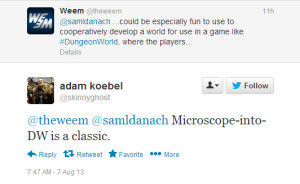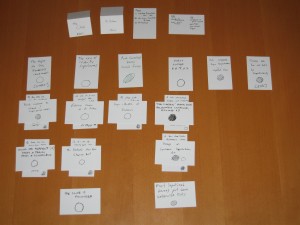As is likely obvious from the posts around here recently, I have been playing Dungeon World (and loving it). One of the great aspects about the game is the way world-building is handled, specifically by way of using player answers to your questions as a primary means of development. I may ask a player who the ruler is of these lands, noting their answer as the latest addition to the world, for example. This cooperative approach really gives the players ownership of the world and allows everyone build it together. However, it can also be a source of apprehension for players not accustomed to this very improvisational approach, especially when they are in the spotlight.
Microscope RPG

Microscope RPG (or simply, “Microscope”) is a game that I only (very) recently discovered, having seen Paul (@pdunwin) mention it on Twitter just yesterday. His tweets seemed to indicate he was playing a game that covered a very epic scale, and some really crazy (fun) elements. For example, one of his tweets…
Tonight’s #MicroscopeRPG game saw magic sucked from the world by the dwarves, to be replaced by monstrous technologies, leading to luddism.
Essentially you begin with a blank timeline that has a beginning and end. A theme is decided upon (for example, Sci-Fi) and play begins by going around the table deciding what to “add” to the game and what to “ban”. One player may want to be sure “Robots” are part of this, and as such choose to “Add” them. Another play may ban magic, and so on. After everyone has had enough chances to add/ban elements such that everyone feels ready to start, you continue. From their site…
Play is simple. On your turn you get to create a piece of history. You can make one of three things: either a Period (a large swath of time in the history), an Event (a specific thing that happens inside a Period, like a city being sacked or a soldier coming home from the wars), or a Scene (role-playing to find out what happens in a particular moment in an Event). It’s a three-level outline: Periods contain Events which contain Scenes. You put down a card for each thing you make to keep track of the timeline.
When scenes are created, the creator of said scene poses a question. An example question they have reads: “can the seventh rune of power destroy the very gods?“. The players then all role-play together, playing various characters important to the scene until the players feel the question has been sufficiently answered.
When does the game end? Well, as they say, it doesn’t! You can keep coming back to a particular game and continue to play out more and more details.

But Dungeon World doesn’t require a world history
It’s true that in Dungeon World the players are a key component to developing the world in which they play, as I mentioned above. However, this is a very alien concept to some players. Many players I know have played games like D&D for many years, including myself. We are very much used to asking the GM, “what is the King like?” and having him/her dictate those details to us. But when, in the case of Dungeon World, the GM turns the question around asking the player, “I don’t know what the King is like… you tell me!“, many players freeze up.
To be sure, I have some amazing players who take to this quickly. They latch on to it and really enjoy developing the world when prompted with these questions, but even they can have moments of world development block – moments when they just aren’t sure, or need a minute to think about it.
Dungeon World does not need to have a rough world history developed ahead of time – BUT – involving the players in such steps could help give them a theme, idea or guideline to refer to when faced with such questions during the (Dungeon World) game. They are now answering from a foundation they played a hand in establishing, which is empowering and can, I think, inspire them with ideas more quickly and confidently.
Microscope RPG and Dungeon World in action!
As I showed in the image up top, it turns out Adam Koebel (co-creator of Dungeon World) has in fact played this out starting with Microscope and then following that setup into Dungeon World. In fact, in response to a post I made on Dungeon World Tavern (DW G+ Community) he provided this bit I want to leave you with, to demonstrate the possibilities, taken a step further…
We did it once without any kind of modification to either game. Play Microscope with a set of pre-defined “have to include” elements – elves, dwarves, arcane and divine magic, etc and then just play it out. Pick a card at the end and say “let’s do an adventure, here!” you can come back for later adventures and play the descendants of your characters, or the same character, for long-lived races!
Whether or not I end up using Microscope to develop a world history with my players for Dungeon World, I really do like the idea of working up a world history with them, whatever game we play.
Related Links!
Microscope
Dungeon World
